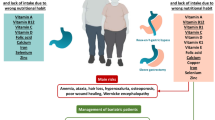Abstract
Ileal pouch-anal anastomosis (IPAA) is a classical surgery for ulcerative colitis patients. However, knowledge on trace element alteration in patients who had undergone this surgery is limited. This study was conducted to assess trace element alteration in patients with ulcerative colitis before and after ileal pouch-anal anastomosis. Preoperative (40) and postoperative (35) ulcerative colitis patients were studied. The dietary assessment of trace element intake was undertaken by a semiquantitative food frequency questionnaire. Patients' trace element status of zinc, copper, manganese, selenium, calcium, iron, and vitamin D3 was assessed by measuring their blood concentrations. We found that with the similar dietary intake, there was no statistical difference in the concentrations of plasma copper, iron, calcium, and vitamin D3 in the two groups (P > 0.05). Compared with preoperative patients, postoperative patients had higher concentrations of plasma zinc (14.51 ± 4.75 μmol/l) and manganese (0.21 ± 0.11 μmol/l) and lower concentrations of plasma selenium (0.86 ± 0.58 μmol/l). Both preoperative and postoperative mean concentrations of plasma calcium and vitamin D3 were below their reference range, respectively. We conclude that IPAA does not seem to alter patients' abnormal trace elements completely. It is important to monitor and supply some specified trace elements even in postoperative patients.
Similar content being viewed by others
References
Pemberton JH, Kelly KA, Beart RW Jr et al (1987) Ileal pouch-anal anastomosis for chronic ulcerative colitis. Long-term results. Ann Surg 206(4):504–513
Ringstad J, Kildebo S, Thomassen Y (1993) Serum selenium, copper, and zinc concentrations in Crohn's disease and ulcerative colitis. Scand J Gastroenterol 28(7):605–608
El Muhtaseb MS, Duncan A, Talwar DK et al (2007) Assessment of dietary intake and trace element status in patients with ileal pouch-anal anastomosis. Dis Colon Rectum 50(10):1553–1557
Razack R, Seidner DL (2007) Nutrition in bowel disease. Curr Opin Gastroenterol 23:400–405
Valentini L, Schaper L, Buning C et al (2008) Malnutrition and impaired muscle strength in patients with Crohn's disease and ulcerative colitis in remission. Nutrition 24:694–702
Finamore A, Massimi M, Conti DL et al (2008) Zinc deficiency induces membrane barrier damage and increases neutrophil transmigration in Caco-2 cells. J Nutr 138:1664–1670
Zhang B, Guo Y (2009) Supplemental zinc reduced intestinal permeability by enhancing occludin and zonula occludens protein-1(ZO-1) expression in weaning piglets. Br J Nutr 102(5):687–693
Chin AC, Lee WY, Nusrat A et al (2008) Neutrophil-mediated activation of epithelial protease-activated receptors-1 and −2 regulates barrier function and transepithelial migration. J Immunol 181:5702–5710
Xue W, Cheng-en P (2000) The relation between the nutritional status and the trace element status of patients in general surgery and its clinical significance. Parenter Enter Nutr 7(1):34–37
Rajendran N, Kumar D (2010) Role of diet in the management of inflammatory bowel disease. World J Gastroenterol 6(12):1442–1448
Osada T, Ohkusa T, Yokoyama T et al (2010) Comparison of several activity indices for the evaluation of endoscopic activity in UC: inter- and intraobserver consistency. Inflamm Bowel Dis 16(2):192–197
Ziyuan Z, Wenchang W, Liping S et al (2003) Validity and reliability study of a semi-quantitative food frequency questionnaire in Chongqing adults. Acta Acad Med Militaris Tertiae 25(19):1706–1709
Jowett SL, Seal CJ, Phillips E et al (2004) Dietary beliefs of people with ulcerative colitis and their effect on relapse and nutrient intake. Clin Nutr 23(2):161–170
Hendricks KM, Walker AW (1988) Zinc deficiency in inflammatory bowel disease. Nutr Rev 46:401–408
Sturniolo GC, Molokhia MM, Shields R et al (1980) Zinc absorption in Crohn's disease. Gut 21:387–391
Sturniolo GC, Mestriner C, Lecis PE et al (1998) Altered plasma and mucosal concentrations of trace elements and antioxidants in active ulcerative colitis. Scand J Gastroenterol 33:644–649
Davis CD, Malecki EA, Greger JL (1992) Interactions among dietary manganese, heme iron, and nonheme iron in women. Am J Clin Nutr 56:926–932
Finley JW (1999) Manganese absorption and retention by young women is associated with serum ferritin concentration. Am J Clin Nutr 70:37–43
Silvennoinen JA, Karttunen TJ, Niemela SE et al (1995) A controlled study of bone mineral density in patients with inflammatory bowel disease. Gut 37:71–76
Dinca M, Fries W, Luisetto G et al (1999) Evolution of osteoporosis in inflammatory bowel disease. Am J Gastroenterol 94:1292–1297
Etzel JP, Larson MF, Anawalt BD et al (2011) Assessment and management of low bone density in inflammatory bowel disease and performance of professional society guidelines. Inflamm Bowel Dis 17:2122–2129
Shen B, Remzi FH, Oikonomou IK et al (2009) Risk factors for low bone mass in patients with ulcerative colitis following ileal pouch-anal anastomosis. Am J Gastroenterol 104(3):639–646
Acknowledgments
We thank all the participants of the study. Doctors and nurses of the Department of General Surgery of Tianjin Medical University General Hospital also provided much convenience and assistance during the study. This study was supported by the Tianjin Municipal Health Bureau of Science and Technology Fund: an exploration of surgical treatment standard in intractable ulcerative colitis (number of the proposal: 2010KZ114).
Author information
Authors and Affiliations
Corresponding authors
Additional information
Xinling Ma and Ke Zhao equally contributed to this work and should be considered as co-first authors.
Wang Chunmei and Hongqiu Han equally contributed to this work and should be considered as co-corresponding authors.
Rights and permissions
About this article
Cite this article
Ma, X., Zhao, K., Wei, L. et al. Altered Plasma Concentrations of Trace Elements in Ulcerative Colitis Patients Before and After Surgery. Biol Trace Elem Res 153, 100–104 (2013). https://doi.org/10.1007/s12011-013-9662-3
Received:
Accepted:
Published:
Issue Date:
DOI: https://doi.org/10.1007/s12011-013-9662-3




